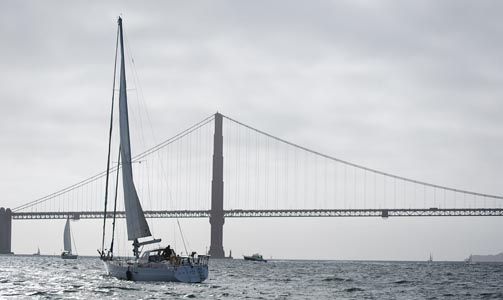About six weeks ago, the US Sailing Association (the national governing body of the sport) held two instructor evaluation courses on San Francisco Bay.

By CaptaIn Ray
Published: December, 2012
About six weeks ago, the US Sailing Association (the national governing body of the sport) held two instructor evaluation courses on San Francisco Bay. US Sailing-affiliated schools host these courses and US Sailing instructor trainers conduct them, evaluating and certifying the instructor candidates.
OCSC Sailing in the Berkeley Marina hosted the first of these two courses, a Basic Keelboat Instructor Course (BKIC). This three-day, entry-level instructor course is designed to examine the presentation, evaluation, time management and sailing skills of those who wish to teach beginning students on small sailboats, typically in the mid-20 foot range. Most, but not all, of these boats are equipped with outboard motors.
Club Nautique in Sausalito hosted the second course. Called a Cruising Instructor Course (CIC), it is also three days long. This course is quite different from the BKIC. With presentation and evaluation skills already confirmed at the Basic Keelboat level, the focus in this course is the organizational and boat handling skills necessary to teach safely on boats up to 50 feet. Because successful completion of the BKIC is required for participation in the CIC and some of the instructor candidates come from great distances, this second course was scheduled immediately after the first, with only a few days between them.
All candidates must prove their ability to swim before being allowed to participate in the BKIC, and they must have current CPR and first-aid certifications. As each instructor candidate enrolls in the BKIC, he or she is assigned two ten-minute classroom presentation topics. The first topic is related to some area of learning theory, such as "handling problem questions" or "purpose/value statements." The other is on sailing theory, such as "tacking" or "how a sail works." The topics are intentionally broad, forcing the candidates to focus on some aspect that can be handled in the short time allotted. Each presentation is timed and then critiqued—first by the presenter, then the other candidates and the instructor trainers.
While still at the dock, candidates are tested on their knot-tying and line-handling skills, and then each candidate must demonstrate how he or she teaches on board the boat. Once underway, each candidate must competently and safely sail the boat single-handed while executing a variety of maneuvers, including overboard rescues. And, of course, there are several written tests to be completed.
The Cruising Instructor Course features a three-day, two-night liveaboard format. Menu planning, provisioning, anchoring (single and multiple), reefing, rafting up, heaving to, picking up moorings, overboard rescues at night, navigation (both day and night), close quarters maneuvering under power, organizing, and supervising crew are examples of what is being examined. And, of course, there is a written test. Coast Guard regulations require that the operators of all commercial vessels equipped with a motor be licensed. Therefore, all cruising instructors must have a Coast Guard license.
(There is a small technicality in the Coast Guard regulations—some might call it a loophole—that allows unlicensed personnel to operate vessels commercially if there is no motor and they carry fewer than six paying passengers. Some schools teach on boats that fit these criteria, therefore US Sailing does not require Basic Keelboat Instructors to be licensed. A school that has motors on its boats will require it, however.)
As you can see from this, by the time instructor candidates have completed all of these requirements and tests, US Sailing can be sure that they have what it takes not only to sail, but to teach in a safe environment. For more information, go to www.ussailing.org.
Ray Wichmann, is a US SAILING-certified Ocean Passagemaking Instructor, a US SAILING Instructor Trainer, and a member of US SAILING’s National Faculty. He holds a 100-Ton Master’s License, was a charter skipper in Hawai’i for 15 years, and has sailed on both coasts of the United States, in Mexico, the Caribbean, and Greece. He is presently employed as the Master Instructor at OCSC Sailing in the Berkeley Marina.

